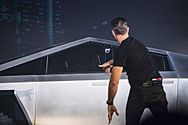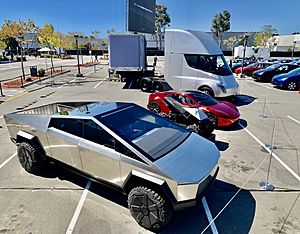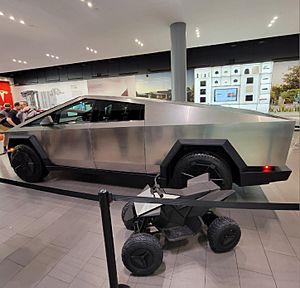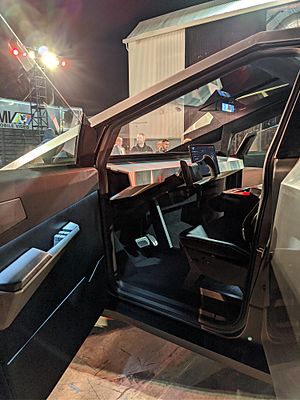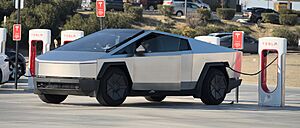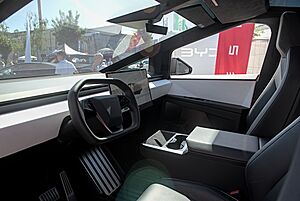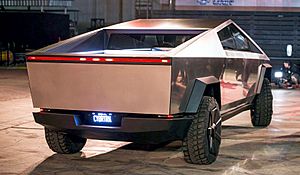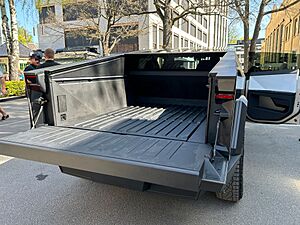Tesla Cybertruck facts for kids
Quick facts for kids Tesla Cybertruck |
|
|---|---|
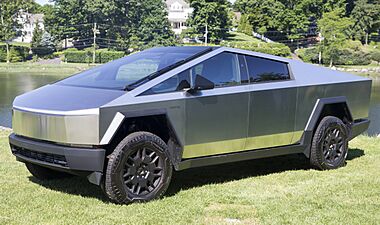
2024 Tesla Cybertruck, Foundation Series
|
|
| Overview | |
| Manufacturer | Tesla, Inc. |
| Production | November 2023 – present |
| Model years | 2024 – present |
| Assembly | United States: Austin, Texas (Gigafactory Texas) |
| Designer | |
| Body and chassis | |
| Class | Pickup truck |
| Body style | 4-door crew cab |
| Layout |
|
| Powertrain | |
| Electric motor |
|
| Transmission | Single-speed fixed (15:1 ratio) |
| Battery | 123 kWh lithium-ion (816 V, 150 Ah) |
| Electric range | 320–350 mi (510–560 km) EPA est. |
| Plug-in charging | |
| Dimensions | |
| Wheelbase | 143.11 in (3,635 mm) |
| Length | 223.74 in (5,683 mm) |
| Width | 79.99 in (2,032 mm) |
| Height | 70.7 in (1,796 mm) |
| Weight |
|
The Tesla Cybertruck is a cool electric pickup truck made by Tesla, Inc. It runs on batteries, not gas! It has been built since 2023.
It was first shown off in November 2019. The Cybertruck has a very unique, angular design. It's made of flat, unpainted stainless steel panels. Some people thought it looked like a low-polygon computer model.
The truck was supposed to start being made in late 2021. But there were many delays. It finally began limited production at Gigafactory Texas in November 2023. The first customers received their trucks later that month.
Right now, there are three main versions. One is called the "Cyberbeast," which has three motors and all-wheel drive (AWD). There's also a dual-motor AWD model. The third is a single-motor rear-wheel drive (RWD) "Long Range" model. The distance the truck can travel on a full charge varies. It can go from about 320 to 350 miles (515 to 563 km). The Cybertruck is only sold in the United States and Canada.
History of the Cybertruck
How the Cybertruck Idea Started
Tesla CEO Elon Musk first talked about making a pickup truck in 2012 and 2013. He imagined a "Tesla supertruck" that would be very powerful. It would have special suspension and handle like a sports car.
In 2015, Musk said the Tesla pickup would be similar to a Ford F-150. By 2016, a consumer pickup truck was part of Tesla's future plans. Musk even suggested the same base could be used for a van and a truck. In 2017, he showed a picture of a "pickup truck that can carry a pickup truck." This was at the event where the Tesla Semi and Roadster were revealed.
In March 2019, Musk shared a hint about a new vehicle. He described it as having a "cyberpunk" or Blade Runner style. It looked like a futuristic armored vehicle.
The 2019 Concept Reveal
A concept version of the Cybertruck was shown in Los Angeles, California, on November 21, 2019. This was the same month, year, and city where the movie Blade Runner was set.
During the event, Tesla said the Cybertruck's "Armor Glass" windows were super strong. But when a metal ball was thrown at them, two windows cracked. Elon Musk later explained that the windows were already weakened. This happened because a sledgehammer had hit the door earlier. Tesla also showed a video of the Cybertruck pulling a Ford F-150 uphill in a tug-of-war. News reporters noted that the Cybertruck won because it was much heavier.
Tesla's goal was to create a clean energy option. This would replace the many gas-powered pickup trucks sold each day.
At the end of the presentation, a concept Tesla Cyberquad all-terrain vehicle (ATV) was driven onto the Cybertruck's bed. It used a built-in ramp. The Cyberquad was plugged into the Cybertruck to charge its batteries. People thought the ATV might be sold later as an option for the Cybertruck.
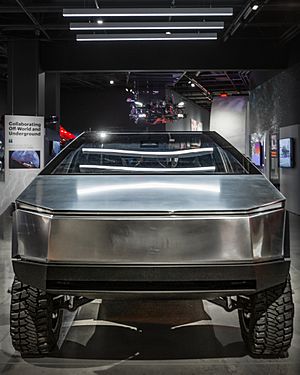
In 2019, many people on social media talked about the truck's sharp edges. They found its look very unusual. The prototype was shown at the Petersen Automotive Museum in June 2020 and again in November 2022.
How People Reserved the Cybertruck
Starting in November 2019, people could reserve a Cybertruck. They paid a refundable $100 deposit. On November 23, 2019, Elon Musk tweeted that Tesla had received 146,000 reservations. This was in just the first day and a half after the reveal. By November 26, the number of reservations grew to 250,000.
In October 2021, Tesla removed the Cybertruck's prices and details from its website. They did not explain why. But they still accepted deposits. At a meeting in 2022, Elon Musk said the final prices and features would be different from what was shown in 2019.
Reservations were stopped for a short time before the first deliveries on November 30, 2023. After that event, the deposit price went up to $250. By August 2024, the Cybertruck was easy to get in the U.S. Tesla then stopped taking reservations completely.
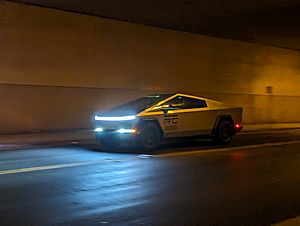
Production and Sales
In 2019, Elon Musk said the Cybertruck would launch in late 2021. The starting price was announced as $39,900. The release date was later moved to 2022, then to late 2023. The updated starting price became $60,990.
In May 2022, Tesla stopped taking orders from customers outside North America. In December 2023, they confirmed the Cybertruck would only be sold in North America. It is very difficult to register the Cybertruck for public roads in many countries outside North America. This is due to different safety rules.
In June 2023, chief designer Franz von Holzhausen drove an early Cybertruck to an event. The very first unit was put together at Gigafactory Texas in July 2023. Tesla later said this was part of "pilot production," meaning they were testing how to build it.
Regular production started by November 2023. Trucks ready for sale began appearing in Tesla showrooms that month. On November 30, 2023, Tesla held a special event. They gave the first trucks to a small group of customers. At the event, they showed the truck's strong glass. They also showed a video of the Cybertruck winning a drag race against a Porsche 911. It even towed another 911 during the race!
At the same event, Tesla announced the prices and details for three versions. These were the single-motor rear-wheel drive (RWD), dual-motor all-wheel drive (AWD), and tri-motor AWD "Cyberbeast."
- The RWD version was priced at $60,990. It was planned for release in 2025. It had an estimated range of 250 miles (402 km).
- The dual-motor AWD model was planned for 2024 at $79,990. It had a range of 340 miles (547 km).
- The tri-motor Cyberbeast was also planned for 2024. It was priced at $99,990.
Compared to the prices first announced in 2019, the starting prices had increased a lot. They were $21,000 to $39,000 higher.
In August 2024, Tesla stopped taking reservations for the basic RWD model. Until October 2024, only a special "Foundation Series" was sold. This version cost $20,000 more. It was limited to 25,000 units. It included early delivery, special badges, and almost all available extras. It also came with features like Full Self-Driving and Powershare. Sales of the Foundation Series ended in January 2025.
Sales of the RWD model, now called the "Long Range" Cybertruck, started again in April 2025. It now had a battery that could go up to 350 miles (563 km). Its price was $69,990, which was $9,000 more than its first listing. Even though it had the longest range, the Long Range model did not have some features. These included cooled seats, a screen for back-seat passengers, a power-operated bed cover, power outlets, and adjustable air suspension.
Cybertruck Design
What Inspired the Cybertruck's Look
Elon Musk said the Cybertruck's design was inspired by the movie Blade Runner. It was also inspired by "Wet Nellie". This was the Lotus Esprit car that turned into a submarine in the James Bond movie The Spy Who Loved Me. Like many vehicles, the Cybertruck can float for short times.
In a book about Elon Musk, his son Saxon asked, "Why doesn't the future look like the future?" Musk used this question as an idea for the design. He repeated it during the delivery event.
Automotive designer Frank Stephenson thought the Cybertruck looked "almost repulsive." But he also said it "has the potential to be extremely beautiful" if its sharp lines were softened. Another designer, Adrian Clarke, was more critical. He called it "a low polygon joke." However, Giorgetto Giugiaro, who designed cars like the Lotus Esprit and DeLorean, said in 2023 that new designs are often seen as "provocation." He believed the Cybertruck would "surely be successful."
Outside Features
The Cybertruck's body panels are made of a special stainless steel. The doors are about 1.8 mm thick, and the body is about 1.4 mm thick. These panels cannot be shaped like regular car parts. Instead, they are cut with lasers and then bent along straight lines. Tesla had to invent a new way to shape the steel using high air pressure.
The stainless steel finish can get rust spots. It needs special care, like not washing the truck in direct sunlight.
Power System (Powertrain)
Tesla uses a standard set of parts for the Cybertruck's power system. This means they use the same basic motors and gears for all versions. This includes the tri-motor, dual-motor, and single-motor trucks. The total power ranges from 845 horsepower in the tri-motor to 315 horsepower in the single-motor version. All the power parts are in a special liquid-cooled unit.
- The single-motor RWD version has one motor in the back. It makes up to 315 horsepower.
- The dual-motor AWD version has a motor in the back and one in the front. The front motor makes 303 horsepower, and the rear motor makes 297 horsepower. Together, they make 600 horsepower.
- The tri-motor AWD "Cyberbeast" has one motor in the front and two in the back. The front motor makes 276 horsepower. Each rear motor makes 284 horsepower. This setup gives a total of 845 horsepower.
Tesla thought about making a four-motor version in 2021. But this version was not included in the trucks released in late 2023.
|
Model
Spec
|
|
All-wheel drive | Cyberbeast |
|---|---|---|---|
| Motors | 1 (rear) | 2 (front, rear) | 3 (front, two rear) |
| Range (EPA est.) | 350 mi (560 km) | 340 mi (550 km) | 320 mi (510 km) |
| 0 to 60 mph | 6.2 sec. | 4.1 sec. | 2.6 sec. |
| Top speed | 112 mph (180 km/h) | 130 mph (210 km/h) | |
| Power | 315 hp (235 kW) | 600 hp (450 kW) | 845 hp (630 kW) |
| Wheel torque | ? | 743.5 lb⋅ft (1,008.1 N⋅m) | 1,029.6 lb⋅ft (1,396.0 N⋅m) |
| Payload capacity | 2,006 lb (910 kg) | 2,500 lb (1,100 kg) | 2,271 lb (1,030 kg) |
| Towing capacity | 7,500 lb (3,400 kg) | 11,000 lb (5,000 kg) | |
Suspension, Chassis, and Steering
The Cybertruck AWD and Cyberbeast models have adjustable air suspension. This helps the truck ride smoothly. The Long Range model has regular coil spring suspension. All models have self-leveling suspension. This means they can adjust for different weights.
The truck can raise or lower itself. It has up to 12 inches (30 cm) of suspension travel. It also has 17.4 inches (44 cm) of ground clearance. This helps it go over bumps and rough terrain.
The Cybertruck uses "steer-by-wire." This means the steering wheel is not directly connected to the wheels. Instead, it uses electronic signals. You can turn the wheels fully with less than one full turn of the steering wheel. The rear wheels can also turn up to 10 degrees. This helps the truck make tighter turns. The steering also adjusts based on speed.
Range, Battery, and Charging
The RWD "Long Range" Cybertruck can go about 350 miles (563 km) on a full charge. The AWD version has a range of about 325 miles (523 km). The "Cyberbeast" can go about 300 miles (483 km).
The Cybertruck has a large battery pack. It holds 123 kWh of energy. This battery is part of the truck's structure. It is made of special "4680 lithium-ion battery cells." The truck also has a "wade mode." This lets it drive through water up to 2.5 feet (0.76 m) deep. It uses a special system to keep water out of the battery.
Tesla says the battery can charge very quickly. It can get up to 350 kW at special charging stations. Tesla claims you can add about 128 to 136 miles (206 to 219 km) of range in just 15 minutes. The truck's built-in charger can also take AC power at home.
The dual-motor and tri-motor Cybertrucks can provide power to other devices. They have five outlets that can give up to 9.6 kW of power.
- Four 120 V outlets: two inside the cabin and two in the truck bed.
- One 240 V outlet: located in the truck bed.
The RWD version can provide up to 2.4 kW of power. It uses a special adapter that plugs into the truck's charging port. This adapter gives 120 V outlets. The dual-motor and tri-motor versions can also use this adapter. This gives them a total of seven outlets.
All Cybertruck versions can send up to 11.5 kW of power to a home. This is called "vehicle-to-home" (V2H). To do this, you need a Tesla Wall Connector and a Tesla Gateway or Powerwall system. As of 2025, the Cybertruck cannot send power back to the main electrical grid.
Inside the Cybertruck
The Cybertruck has five seats. There are two in the front and a three-seat bench in the back. Most controls are on a large 18.5-inch (47 cm) touchscreen in the front. This screen controls the air conditioning, music, and vehicle settings. The AWD and Cyberbeast models also have a 9.4-inch (24 cm) touchscreen for the back-seat passengers. The steering wheel has a unique "squircle" shape. It is flat on the top and bottom, but round on the sides.
Truck Bed (Cargo Bed)
The Cybertruck has a cargo bed that is 6 feet (1.8 m) long and 4 feet (1.2 m) wide. It has a volume of 67 cubic feet (1.9 m³). The dual-motor and tri-motor versions have a motorized hard cover for the bed. The RWD version does not come with this cover. However, a soft cover can be bought separately.
When the bed cover is closed, you cannot see out of the rear window. To help with backing up and towing, the view from rear cameras is shown on the main touchscreen.
The dual-motor and tri-motor versions have extra features in the bed. These include LED lights along the sides. There is also a hidden storage area under the main bed floor. And they have built-in 120 V and 240 V power outlets.
Cybertruck Safety
In its first year, the Cybertruck had some issues. There were 26 complaints, two investigations, and seven recalls by the National Highway Traffic Safety Administration (NHTSA). As of 2025, the Cybertruck is not allowed on roads in the United Kingdom. It also does not meet European Union safety standards for pedestrians.
Safety experts have worried that the Cybertruck's angular design and stiff stainless-steel outside could be a risk. They are concerned it might cause more harm to pedestrians, cyclists, and other vehicles in a crash. The very stiff "exoskeleton" might reduce how well the truck absorbs impacts. The tall, flat front of the truck could also make injuries worse for pedestrians who are hit. Some experts thought it might not pass safety tests in countries like Australia. Tesla has said the Cybertruck's structure would absorb impacts. They also noted it passed U.S. safety checks. However, they admitted it would be very hard to meet EU pedestrian safety laws.
Recalls
As of March 2025, the Cybertruck has had eight recalls. Some of these were fixed with software updates that owners could install. But others needed owners to take their truck in for a repair.
| Recall date | Category | Issue | Solution |
|---|---|---|---|
| January 29, 2024 | Electrical | Warning lights on the dashboard were too small to read easily. | Software update |
| April 16, 2024 | Speed control | The accelerator pedal could come loose and get stuck, causing unwanted speed. | Pedal assembly replacement |
| June 18, 2024 | Structure | A trim piece on the truck bed could come loose and fall off. | Tape or adhesion replacement |
| June 18, 2024 | Visibility | The windshield wiper could stop working, making it hard to see. | Wiper motor replacement |
| September 25, 2024 | Back-over prevention | The rearview camera image was delayed, increasing crash risk when backing up. | Software update |
| November 24, 2024 | Electrical | A part called the inverter could fail, causing the truck to lose power. | Drive inverter replacement |
| December 17, 2024 | Tires | There was an issue with the tire pressure warning light. | Software update |
| March 20, 2025 | Structure | An outside trim panel made of stainless steel could come unglued and detach while driving. | Trim panel replacement |
Incidents
There have been some notable incidents involving the Cybertruck. One event in Las Vegas in 2025 involved a Cybertruck.
See also
 In Spanish: Tesla Cybertruck para niños
In Spanish: Tesla Cybertruck para niños


